
Buying an awning made easy: What you should consider before buying your dream model!
Awnings for camping professionals: everything you need to know!
Caravan awnings
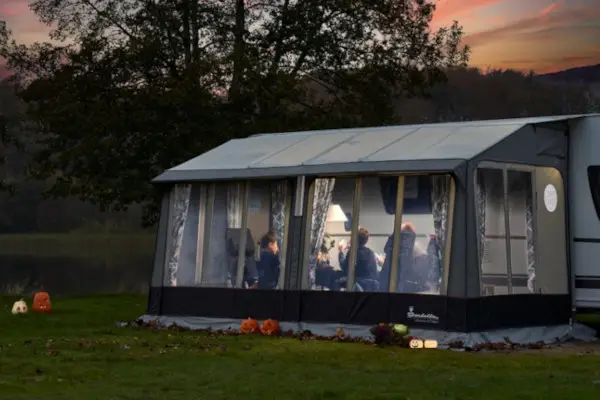
Why buy an awning?
The advantages of a caravan awning are numerous - in the following article you will find the benefits at a glance:
►Additional space: A caravan awning offers you and your family additional living space and therefore more room for your furniture, equipment or an additional sleeping area for your children or visitors.
►Protection from the elements: You are well protected in all weather conditions, whether rain, wind or sun.
► Increased privacy: To spend cosy evenings with friends or as a couple, an awning is the ideal addition to separate you from the rest of the campsite.
What type of awning are you?
Determine the right awning size for your caravan

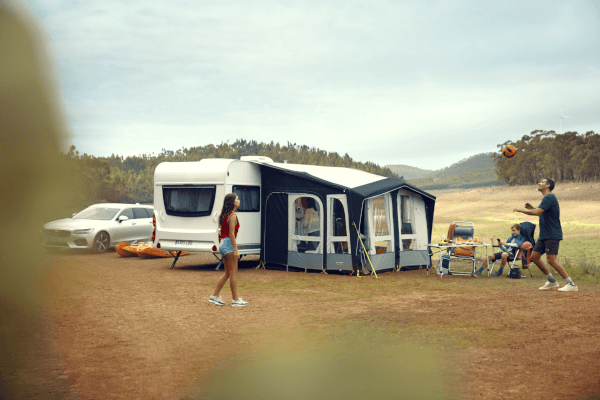
Partial retractable awnings
Partial retractable awnings are only attached to the straight piping rail of your caravan and full retractable awnings cover the entire piping rail, i.e. the circumference. With partial retractable awnings, the only decisive factor is therefore the length of your straight piping rail. The connection height is only important if you have a higher vehicle, such as the Bürstner Averso Plus etc.
Fully retractable awnings
As the full retractable awnings go over the entire piping rail, i.e. the circumference, you need the dimensions of your caravan. The circumferential dimension is measured from the ground along the entire piping rail to the other end on the ground. If you do not know the dimensions of your vehicle, you have the following options for finding out or determining them: Check the documents for your vehicle. As a rule, the overall dimensions can be found in the technical data. Contact the caravan manufacturer or your dealer directly. They can help you at any time by providing the model and year of manufacture. Simply contact us! We have a database with the dimensions of various vehicle models. Measure yourself - You will need a flexible tape measure and a ladder to measure the overall dimensions of your caravan yourself.
- Place your caravan on a flat surface and lower the supports to keep it stable.
- Place the ladder next to the caravan so that you can reach the roof.
- Then measure once from floor to floor along the entire piping rail. The easiest way to do this is to use a non-stretchable rope, which you attach to the ground on one side and then pull through the piping rail to the other side of the caravan on the ground.
- Mark the spot and then simply measure the length of the rope used. If your caravan has a very aerodynamic front, measure up to a height (distance to the ground) of 185 cm, and from there simply measure vertically downwards.
Camper- and Motorhomeawning
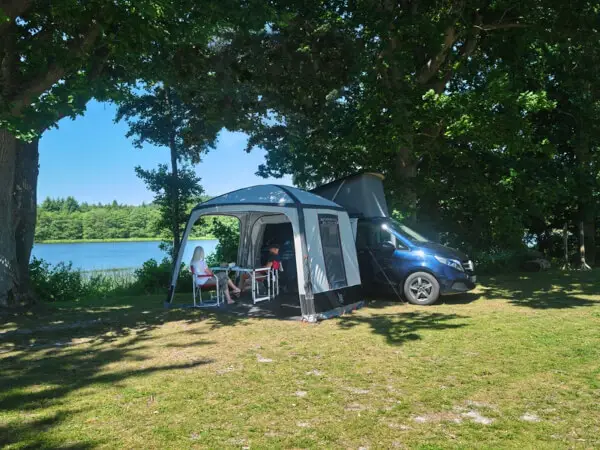
The right awning for campers on four wheels
Awnings are a great addition to any camping trip with a bus or motorhome. They offer you extra space and protection from the elements. If you're looking for a coach awning, there are a few things to consider to make sure you choose the right one for your needs.
Make sure that the awning is hard-wearing and weather-resistant to withstand any weather conditions. You can choose between different polyester materials or cotton blend fabrics. Cotton blend fabric is breathable and therefore allows good air circulation in the awning and reduces condensation. Polyester is lightweight, quick-drying and robust. The choice of material naturally depends on your own needs and the weather conditions at your holiday destination.
It is often the case that you only have a limited amount of storage space, so it is important that the awning is light and compact to save space and weight.
Make sure that the awning has sufficient ventilation options to prevent condensation and ensure pleasant air circulation.
Think about what you want to use the awning for. Will you only be using it for short stays? Then a simple and lightweight awning may be sufficient. Are you spending a longer period of time in the awning and using it as a living or sleeping area? Then you should choose a better equipped awning.
Compare the prices of different awnings and choose one that is within your budget and meets your needs.
Think about how you want to spend your camping holiday and whether you change your pitch several times. If you want to be able to separate the awning from your vehicle, e.g. to go on excursions during your camping holiday, a freestanding awning with an airlock may be the better choice. The airlock is a small space between your vehicle and the actual awning. It serves as a transition area and prevents insects and dirt from entering the interior of the vehicle. The airlock can also be used as additional storage space for equipment and items. A static awning, on the other hand, is a tent that is permanently attached to the vehicle. It is usually set up for a longer period of time and stays in one place without being moved. It usually has no additional airlock that serves as a transition between the interior of the awning and the exterior.
Determine the right awning size for your vehicle
To determine your connection height, you simply need a tape measure or folding rule and measure from the floor to the roof of your vehicle. As a rule, the mounting heights for bus awnings from the various manufacturers are between 175 - 220 cm. The procedure is exactly the same for motorhomes, camper vans or panel vans, measured from the ground to the lower edge of the awning. The mounting heights of awnings start at 220 cm. The decisive factor here is whether you want to attach your awning to the awning of your vehicle. If so, the width of the awning is also important to know. If you retract the awning into the awning, you can subtract approx. 10-15 cm from the width of your awning so that the box closes properly when the awning is retracted.
► Tip
Bus awnings and many motorhome awnings have an airlock sewn onto the tent or the airlock is connected to the awning with a zip. All airlock awnings are the ideal and suitable choice for vehicles with sliding doors, because you want to get back into your camper. As the airlock does not require any poles or air hoses to press against the side wall of your vehicle, you can open and close your door without any problems. This is
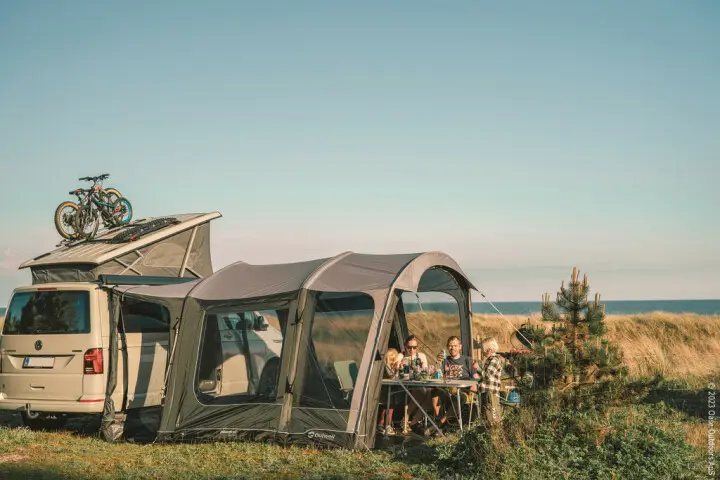
The right attachment: Tips for fitting awnings to your vehicle
The question usually arises: "Do I want to stay with my vehicle permanently?" or "I want to be self-sufficient, leave my awning and explore the holiday destination with my van, how does that work?" There are many different ways to attach your awning to your vehicle
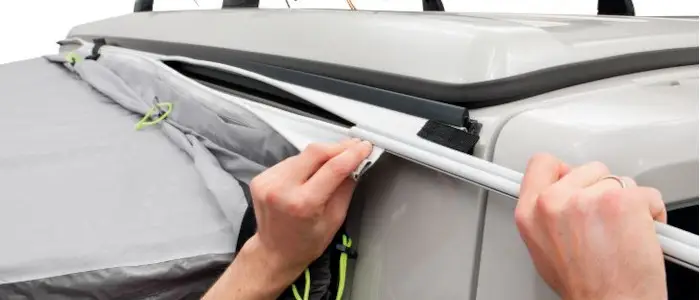
Keder adapter
You are extremely flexible with a piping adapter. The various manufacturers often have a double piping tape, 7-7 + 5 mm or 6-6 + 4 mm - this depends on which awning or piping rail your vehicle has. The piping tape is threaded into the rail or awning of your vehicle and then connected to the awning piping using a double profile rail. If you want to drive away with your vehicle, simply pull out the double profile rail.
► Ideal for motorhomes and panel vans
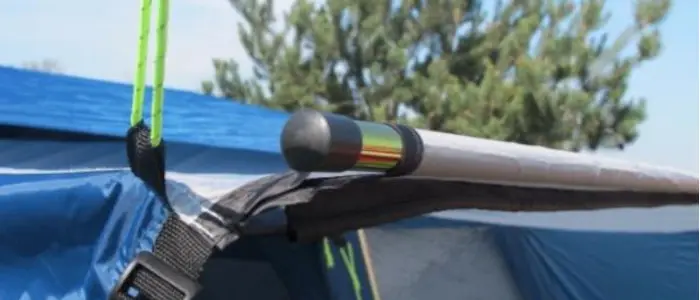
Lock rod and clamp on the rain gutter
Many bus awnings are supplied with a sluice pole. This is inserted through the hemstitch of the airlock and then pushed through the rain gutter. The clamps are then attached on both sides so that nothing can slip.
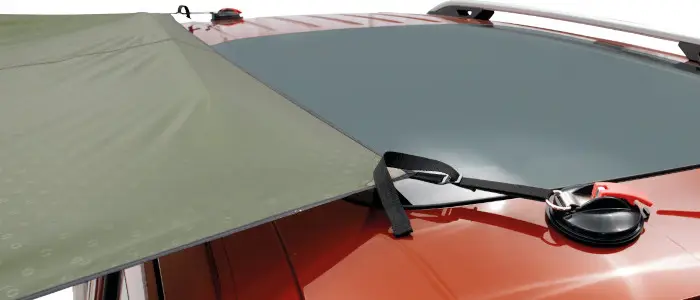
Sluice bar and hinged suction cups on the roof
Important note: The surfaces on the roof must be clean and dry in order to use the hinged suction cups. The sluice bar is pushed through the hemstitch of the sluice and clamped into the hinged suction cups. Two hinged suction cups are sufficient for fastening.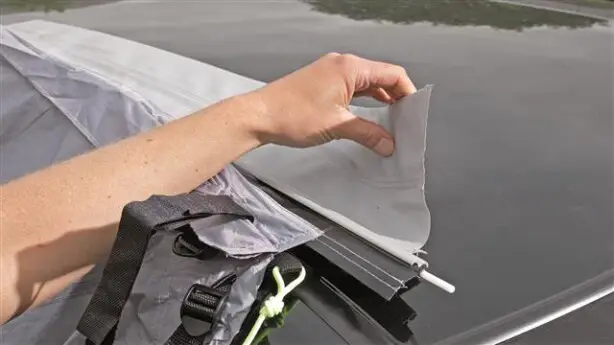
Magnetic adapter on the roof
Magnetic adapters are only suitable for vehicles with a sheet metal roof. The magnetic tape is attached to the roof and then the awning piping is connected to the piping of the magnetic tape with a double profile rail.
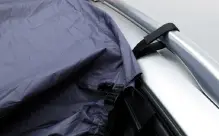
Velcro fasteners on roof rails
If your camper has roof rails or a luggage rack, you can attach the lock to the rails or luggage rack using the Velcro fasteners provided with a lock rod inserted into the hemstitch.
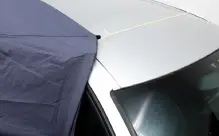
Guy ropes over the roof
Your awning is tensioned over the vehicle roof with the supplied or firmly sewn (depending on the manufacturer) guy ropes and anchored with a peg.► Ideal for motorhomes and camper vans
Materials & rods
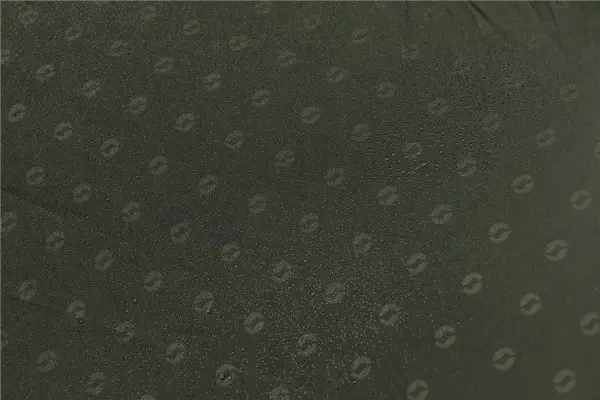
The right choice: tent materials and their advantages and disadvantages:
There is no one perfect tent material for awnings, as each can have its own positive characteristics as well as a downside. For example, a tent coating that is very waterproof can lead to increased condensation on hot days. Well-known tent manufacturers use a variety of materials, including polyester, Airtex, PVC coatings, PU coatings and acrylic.
Airtex is also extremely tear-resistant and has high light and colour fastness. Dirt can be easily removed as with Trailtex.
Awnings with a PVC coating are completely waterproof, extremely tear-resistant and easy to clean. However, they are also relatively heavy and require good ventilation to prevent condensation. PVC is used in the roof area for all tent categories and in the side and front wall area for seasonal, all-season and winter tents.
PU coatings are very cold-resistant and waterproof and are often used for tent floors. They achieve a high density and are of high quality.
Acrylic is very rot-proof and permeable to water vapour, but the tent fabric takes longer to dry. Impregnation makes the acrylic surface water and oil repellent and easy to clean.
The importance of well-made seams for your tent
Awnings are usually made from waterproof materials, but they need to be breathable to prevent condensation. The seams on awnings are therefore particularly important, as they are often the weakest points and must prevent moisture from penetrating.
When manufacturing awnings, the seams are usually sealed by welding or gluing. Swelling seams are special seams that are used to achieve a particularly effective seal. A water-repellent adhesive is applied to the fabric panels. When this adhesive comes into contact with water, it swells and seals the pinholes created during sewing. This creates a waterproof and durable seam that guarantees a long service life for the awning. However, cracks or leaks can occur due to improper use or ageing of the materials.
If a seam is leaking or broken, you should repair it as quickly as possible to prevent further damage. There are special repair kits on the market for this purpose that are customised to the awning material. Depending on the type of damage, it may also make sense to commission a specialist company to carry out the repair.
Tip
It is also advisable to regularly check all seams of the awning for damage or leaks and repair them if necessary. This will ensure that your awning stays dry even in bad weather and remains loyal to you for a long time.
The water column of tents: Meaning and important points when buying
The water column in a tent refers to the ability of the material to repel water. It is measured in millimetres (mm) and indicates how much water pressure the material can withstand before it starts to let water through. The most important points about the water column of a tent that you should consider when buying a tent:Different pole variants for awnings
Awnings can be equipped with different pole variants. Here you will find the most important variantsAdvantages and disadvantages of the frame variants at a glance:
► Steel poles : +Care, accessories & tips
How to clean your awning properly
The best way to clean your awning is to use lukewarm water and a soft sponge or cloth. Alternatively, you can also use a cleaning brush with soft bristles - ideally textile bristles so as not to weaken the material and damage the waterproofing layer. For stubborn dirt such as bird droppings, you can also use tent cleaner.
You should proceed as follows when cleaning your awning:
1. Spread out the awning and remove loose dirt with a soft cloth or brush.
2. Before using the tent cleaner, first moisten the area to be cleaned.
3. Once you have applied the cleaner, use your soft cloth or brush again and rub it in.
4. After rubbing, rinse the affected area well and allow the awning to dry thoroughly to prevent mould growth.
► Tip: After basic cleaning, it is advisable to re-impregnate the area to be on the safe side and ensure that the protective layer remains intact.
How to waterproof your awning correctly
When waterproofing your awning, you should ensure that it is completely clean and dry. Use a waterproofing spray or a waterproofing solution according to the manufacturer's instructions. Please note that the impregnation may wear off after some time and that the awning will need to be treated again. We recommend impregnating the awning after every cleaning or every 1-2 years. You can find all the important information in this video.How to store your awning correctly
You should observe the following when storing your awning: 1.Condensation in the awning: causes and background information
If you have an awning for your caravan or motorhome, you may have noticed that condensation sometimes forms in the tent. This is due to the difference in temperature between the inside and outside air and can be unpleasant. But don't worry, with our tips and tricks you can reduce or even avoid condensation.
To understand how condensation occurs, you need to know that warm air can absorb more moisture than cold air. When the warm, humid air hits cold surfaces such as the tent, it cools down and releases its moisture in the form of condensation. The same happens when warm air enters a cooler tent.
Tips and tricks against moisture in the tent
To reduce condensation, you should ensure that the tent is well ventilated. Let fresh air in from time to time during the day and open the windows and doors to increase the air flow. However, when you leave the awning, you should close it to prevent rain or wind from penetrating inside, andTips in the event of air loss or leaks
If air loss occurs in an inflatable awning, this can be very annoying. The most common reason for a loss of air in an inflatable awning is a leaking valve. Check all valves carefully for cracks or damage. If necessary, use a valve repair kit to repair them. You can also watch our videos on the various manufacturers.
how to recognise a leak in an air awning:
► Check the seams: Check the seams of the tent for tears or damage. If you find tears or holes, you should repair them or replace the tent.
► Checking the valve: Check the valve for any damage or tears. If you find cracks or holes, you must replace the valve.
► Air pressure test: Inflate the tent completely and seal it carefully. Check whether the air pressure decreases after a while. If this is the case, you have a leak in the tent.
How to repair a leak:
► Using a repair kit: Many manufacturers offer special repair kits that you can use to repair holes or tears in the tent.Your awning checklist: Useful accessories for your camping adventure
A storm strap set can help to ensure that the tent remains stable and is not damaged in strong winds or storms. It can reduce the risk of storm damage and therefore increase safety in the tent.
They are another option, but waterproof tarpaulins are not popular on many campsites as they can damage the grass. For this reason, many campers opt for the outdoor carpet. For campsites that are particularly exposed to the weather, however, a waterproof tarpaulin may be a better choice. This special tarpaulin not only protects against dirt, but also against rain and other weather influences.
With polyester awnings in particular, an inner canopy reduces condensation and thus ensures a better indoor climate.
Many campers use a clever trick to ensure that dirt stays outside and is not carried into the caravan: They lay a carpet in their awning. However, this is not a conventional carpet, but a special outdoor carpet made of water-permeable synthetic fibres. This type of carpet allows rainwater to flow through the fibres and the ground underneath remains dry.



























